|
|
|
The
Land
Hans
Ulrich Obrist
|
|
|
|
|
Hans
Ulrich Obrist presenta The Land, il progetto avviato dall'artista Rikrit
Tiravanija nel 1998 in Thailandia su un'area acquistata presso il villaggio
di Sanpatong, vicino a Chiang Mai. Illustrazione di un progetto utopico
nato ai margini delle grandi teorizzazioni. Un esempio di ricerca artistica
condotta al di fuori dei confini dell'oggetto autonomo, lontano dalle
istituzioni del mondo dell'arte e dalle esposizioni che le sostengono.
|
|
|
|
|
More
and more artists today refuse to display their creativity exclusively
within and upon the pristine walls of the gallery space. Their curriculum
vitae increasingly mention such diverse projects as designs for restaurants,
private residences, or public buildings. This inclination of art toward
architecture and design emerges from the revived interest of artists
throughout the nineties to more actively question the role they play
in society. In turning towards collaborative and transdisciplinary practices,
artists have been defining new modes of bypassing formalist credos and
interacting with the social realities of daily life.
Rikrit Tiravanija has been a key figure of these evolutions. Recently
he revealed his ideas concerning "The Land" a large-scale collaborative
and transdisciplinary project taking place on a plot of land that Tiravanija
purchased in the village of Sanpatong, near Chiang Mai, Thailand. The
Land is a laboratory for self-sustainable development but it is also
a site where a new model for art and a new model for living are being
tested out.
|
|
[08jun2003]
|
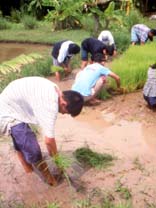
|
|
Begun in 1998, The Land, as Tiravanija explained, "was the merging of
ideas by different artists to cultivate a place of and for social engagement.
It's been acquired in the name of artists who live in Chiang Mai. We've
been trying to find a way to turn it into a collective, and to have
the property owned by no one in particular, but that's one of the hardest
things to do in Thailand. We cannot be a Foundation." The undoing of
ownership strikes at the heart of what Tiravanija is trying to do with
the project since, as he emphasized, "The Land is not a property." And
to the question, then, "Is The Land an art project?" the artist replied:
"We don't want to have to deal with it as a presentation to the art
structures, because I think it should be neutral; and, it's also one
of the reasons why it's not about property." Indeed seeming to underscore
this are the two working rice fields positioned in the middle of the
Land and monitored by a group of students from the University of Chang
Mai and a local village. The harvest, cultivated using traditional Thai
farming techniques, is shared by all participants involved.
|
|
|
|
|
|
Extending
Tiravanija's previous artistic efforts that engage the objects and actions
of everyday life, the Land demonstrates how far contemporary artistic
production today exceeds the boundaries of the autonomous object and
the art systems that uphold it. Although the Land was not initiated
uniquely as a space for structures to be designed, built and used by
artists, many of the projects to date are being developed along those
lines. Thus in its own way, The Land is something of a "massive-scale
artist-run space" in which Tiravanija's incitement to collaborate is
offering artists of all kinds the chance to exceed the boundaries of
their discipline, to construct works they may not have otherwise imagined,
and to allow these works to be developed and experienced in an atypical
way.
|
|
|
|
|
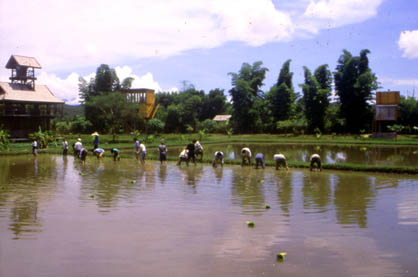
A
slew of contemporary artists have thus designed or carried out projects
for houses or self-sustaining device systems for the Land: Kamin Lerdchaiprasert
built a gardener's house, Atelier van Lieshout developed a toilet system,
Tobias Rehberger, Alicia Framis and Karl Holmqvist worked on housing
structures, and Peter Fischli and David Weiss are building an utopic
busstop inspired by Oscar Niemeyer's Brasilia.
|
|
|
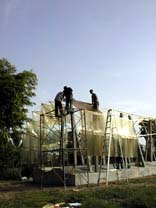
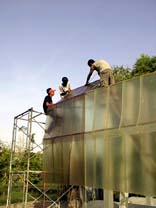
|
|

Some contributions
are structural in other ways: Arthur Meyer constructed a system for
harnessing solar power, Prachya Phintong put in place a program for
fish farming and a water library, Mit Chai-Inn develops tree plants
to be later turned into baskets and the Danish collective Superflex
developed a system for the production of biogas. Tiravanija described
some of the inherent complexities to which the participants were responding:
"There is no electricity or water, as it would be problematic, in terms
of land development in the area. Superflex has made experiments to use
natural renewable resources as alternative sources for electricity and
gas.
|
|
|
|
|
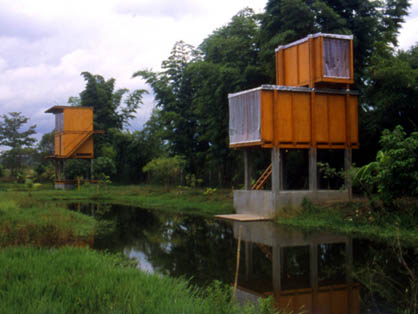
'Supergas'
is using the land as a lab for the development of a biogas system. The
gas produced will be used for the stoves in the kitchen, as well as
lamps for light." Tiravanija himself contributed to the occupation of
The Land with the construction of a house based on what he calls "the
three spheres of needs," described as the following: "The lower floor
is a communal space with a fire place; it's the place of accommodation,
gathering and exchanges; the second floor is for reading and meditation
and reflection on the exchanges; the top floor for sleep."
|
|
|
| |
|
Finally,
Philippe Parreno and the architect François Roche have begun their plans
for a central activity hall that will be built this spring and will
function as a biotechnology driven hyper-plug. The Plug in Station uses
nature to produce the interface: it will make use of a satellite downlink
and a live elephant will generate the necessary power.
|
|
|
|
|
The
Land is already in use. The curious have begun to visit. And, although
there are currently elements in construction and others still yet unrealized,
it is developing in density and layers like the sedimentation of the
plot it sits on. Constructed of the complex exchanges that have, in
some cases, begun between individuals in locations all over the world
and long before Tiravanija staked out its territory, The Land demonstrates
perfectly the "collaborational promiscuity" that interests so many of
the artists involved. To that end, it is important as well that the
Land's collaborative development is somewhat unpredictable, organic,
and ultimately oscillates between process, object, structure, and exchange.
|
|
|
|
|
"The
Land itself," Tiravanija emphasized, "is not connected to anything and
that's what's interesting about it." And this can be understood in many
ways. Above all, Tiravanija's initiation of The Land project resists
the normative and prescriptive aspects which accompanied many earlier
utopias. The Land is a concrete Utopia, but it is also first and foremost
a self-imposed Utopia, one that is not rooted in intransigent beliefs
on how others should live. Thus, The Land stands as a pertinent illustration
of what a utopian project can be once grand theories have been moved
aside: a feasible, practical, but even more importantly, subjective
Utopia.
Hans Ulrich Obrist |
|
|
|
|
|
A
shorter version of this text was published in Wired, issue 11.06, June
2003. |
|
|
|
|
|
|
|
|
|